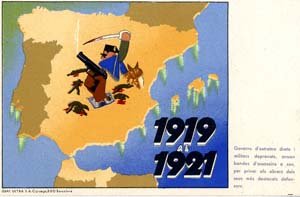1919 AL 1921
Governs d'extrema dreta i militars depravats, armen bandes d'assassins a sou, per privar als obrers dels seus més destacats defensors.
Gobiernos de extrema derecha y militantes depravados, arman bandas de asesinos a sueldo, para privar a los obreros de sus más destacados defensores.
Des gouvernements d'extrême droite, composés de militaires dépraves, entretiennent des bandes d'assassins à gages, dans le but de priver les ouvriers de leurs défenseurs les plus noblest defenders.
Ultra-Right governments, and a depraved Army, arm bands of murderous mercenaries who rob the workers of their noblest defenders.
Registaroj ekstremdekstraj kaj militistoj armigas bandojn de dungitaj murdistoj, senigante la laboristojn je iliaj plej distingitaj defendantoj.
In August 1917, a general strike turned bloody when the army turned out to suppress demonstrators. Around 80persons were killed, 150 wounded. A second general strike in 1919 left the government in a precarious position. Declaration of an eight hour workday ended the strike, but continuing hostility led to further violence between 1919 and 1921, a period known as the "Bolshevik triennium."
One of the more gruesome postcards of the set, this card features a number of corpses associated with the violence of the period 1919-1921. The artist has placed blame on two groups of individuals. In the first case, a smoking gun is shown in the possession of a hand forced through a bill of money. This depiction suggests the involvement of the upper class of employers in the plot to suppress the workers. In the second, an officer of the Civil Guard - identified by his mounted position and the shape of his hat - holds a blood soaked sword. The Civil Guard, a military forced charged with police duties, was called upon by the government to quell disorder.

